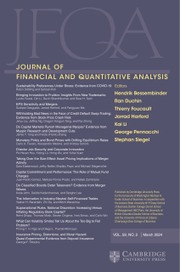Article contents
How Are Firms Sold? The Role of Common Ownership
Published online by Cambridge University Press: 13 May 2025
Abstract
We find that common ownership among acquirers enhances rather than hinders competition in the firm sale process. One common owner raises the likelihood that target firms are sold through auction (vs. negotiation with one buyer) by 21.5%. The effect is causal according to identifications based on mergers between financial institutions. Exploring economic channels, we observe selling firms respond to common ownership among acquirers by avoiding cross-owned acquirers, bargaining hard, and inviting more buyers when cross-owned acquirers initiate the deal but not by terminating the deal. Consistent with enhanced competition, common ownership among acquirers is positively associated with deal quality.
Information
- Type
- Research Article
- Information
- Journal of Financial and Quantitative Analysis , Volume 60 , Issue 7 , November 2025 , pp. 3380 - 3411
- Creative Commons
- This is an Open Access article, distributed under the terms of the Creative Commons Attribution licence (http://creativecommons.org/licenses/by/4.0), which permits unrestricted re-use, distribution and reproduction, provided the original article is properly cited.
- Copyright
- © The Author(s), 2025. Published by Cambridge University Press on behalf of the Michael G. Foster School of Business, University of Washington
Footnotes
For their comments and suggestions, the authors thank Ran Duchin (the editor), an anonymous referee, Jack He, Kai Li, Michele Lowry, Roni Michaely, Martin Schmalz, Jared Smith (discussant), Todd A. Gormley, Vladimir Vladimirov, Wei Wang (discussant), and seminar participants at the 2020 MFA conference, the 2020 NFA conference, the 2020 FMA conference, the University of South Carolina, and the Stockholm Business School. Special thanks go to Jack He and Jiekun Huang for sharing with us their data on mergers between financial institutions. All remaining errors are our own.
References
- 1
- Cited by

